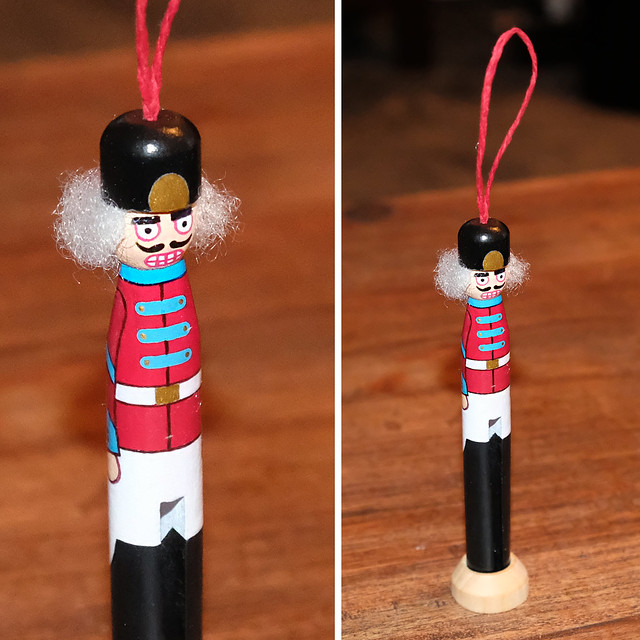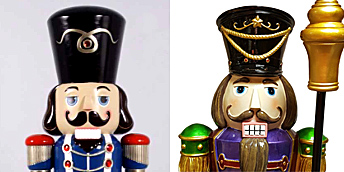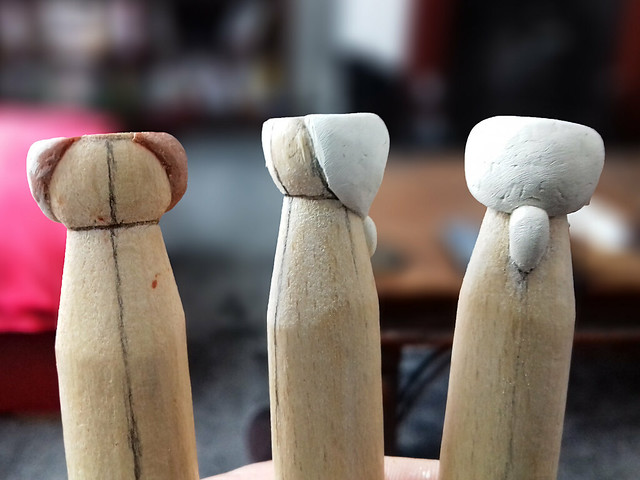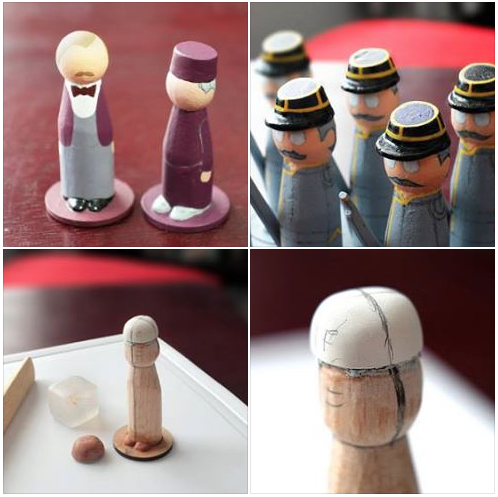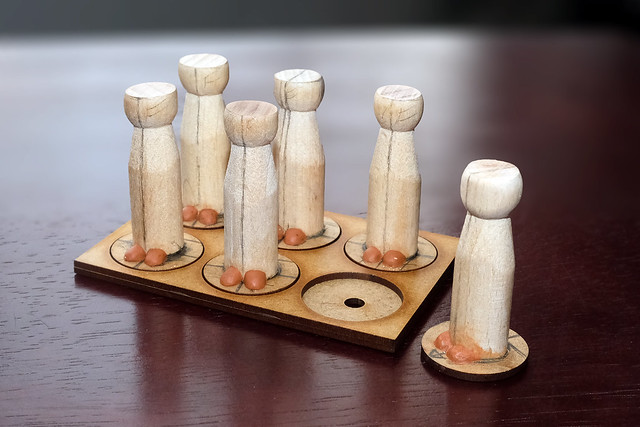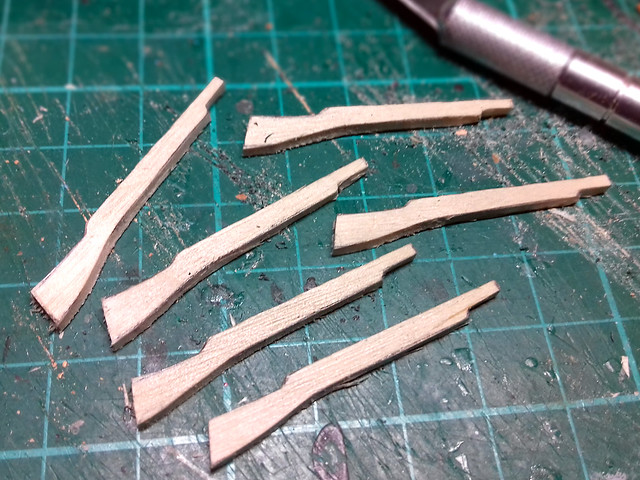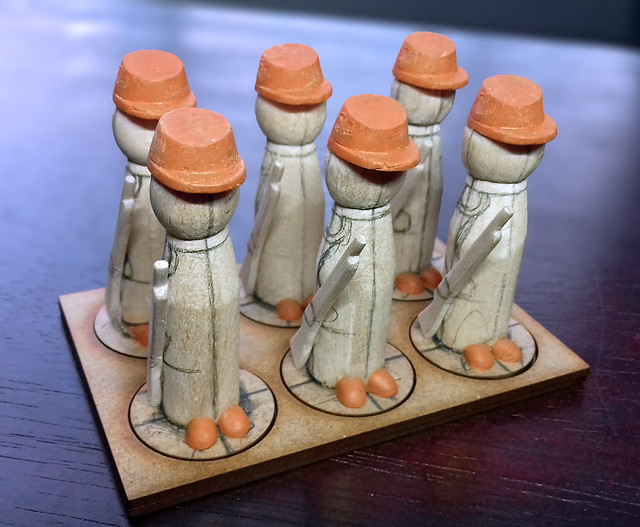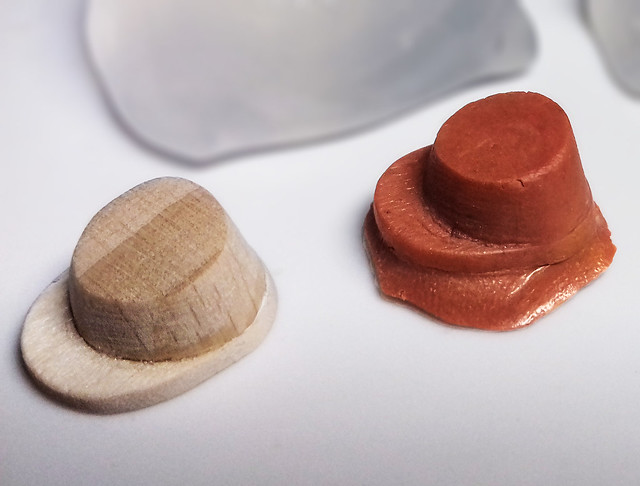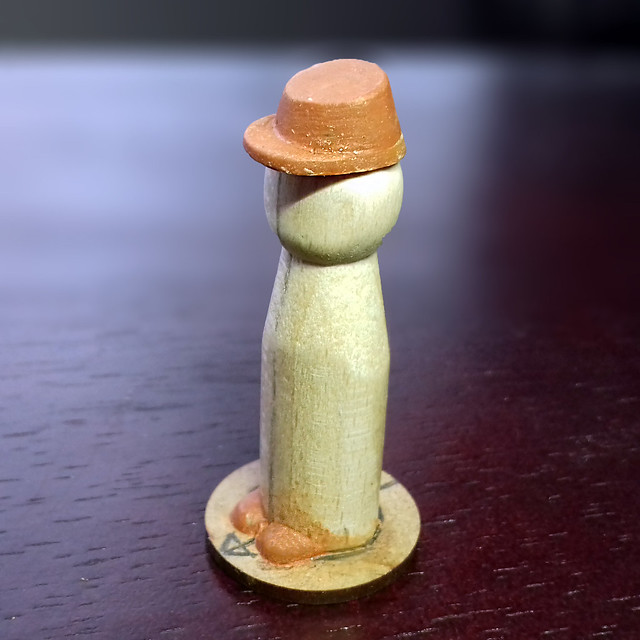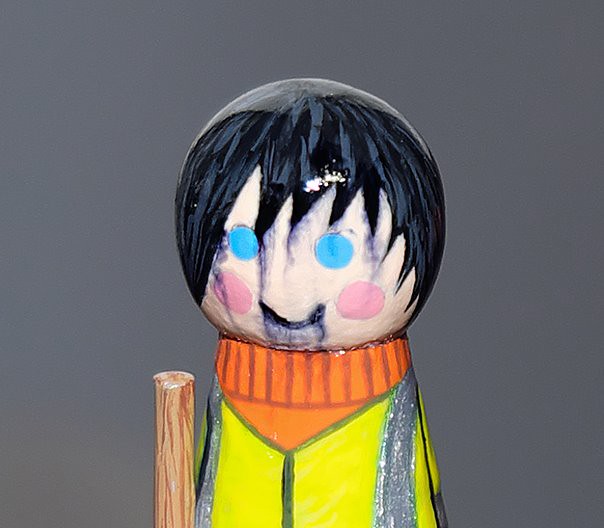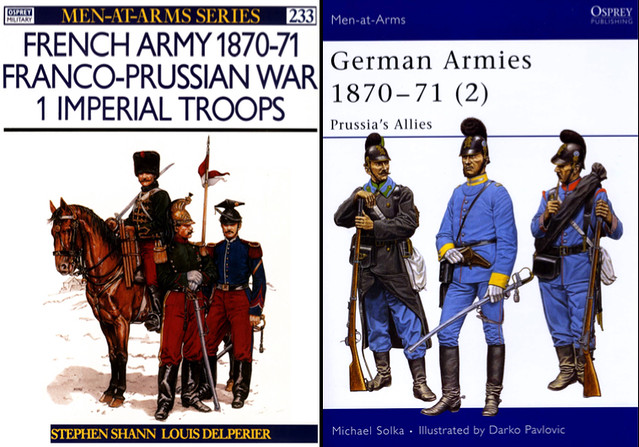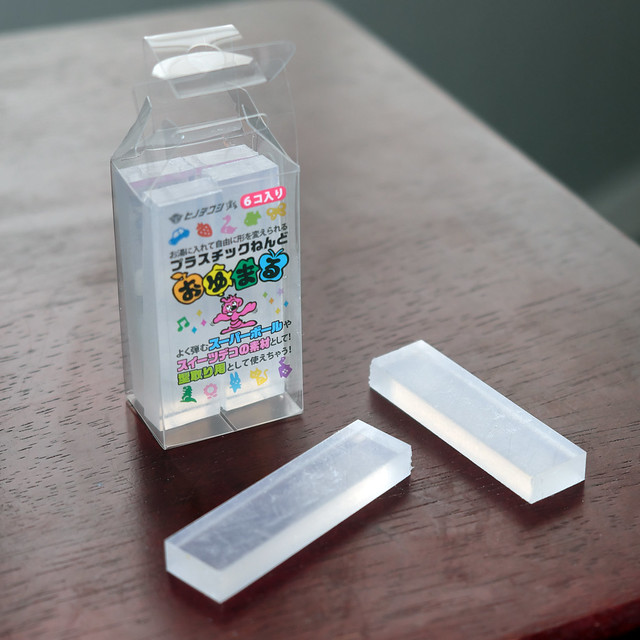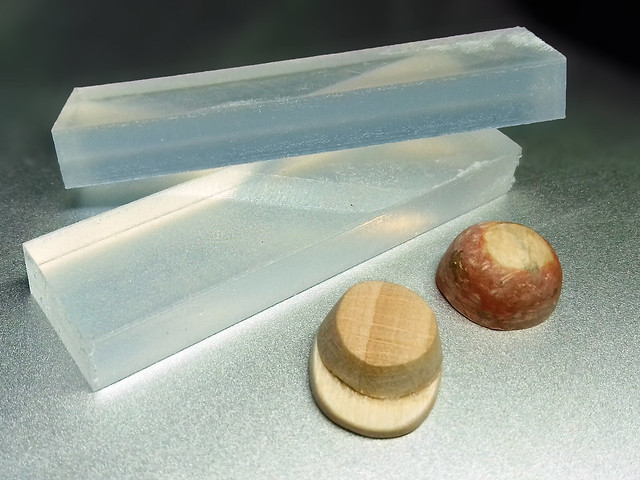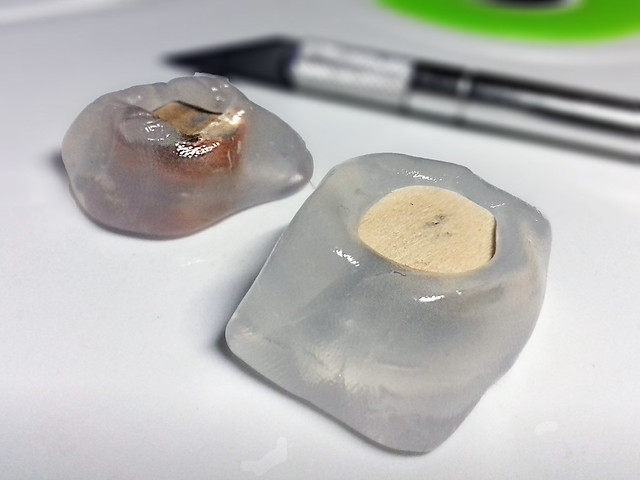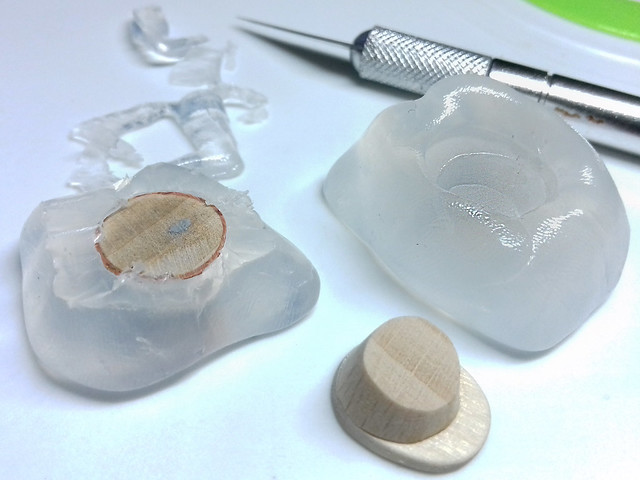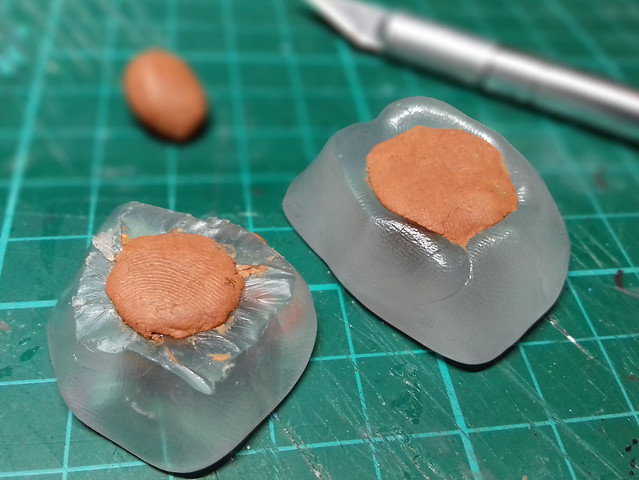My first attempt at making a mini traditional Christmas nutcracker soldier was, in my opinion, only moderately successful. My main frustration was the way I made the hair. The crazy fluffy albino 'afro' just didn't work for me as it was hard to attach, lost it's shape easily and would be easy to pull out again...
So I put this project on the shelf and had a bit of a think how I might improve the look.
Well, I'm having a second go and this time I'm making a solid hair-piece out of my old favourite sculpting medium - Milliput. I've been looking at different versions of the nutcracker soldier and some have been made with solid hair rather than the fake fur hair versions...
Of course, these are 'fake' nutcrackers - or rather, they are stylised versions of the traditional wooden nutcracker soldiers - which is why they have 'solid' hair integral to the model. The real Christmas Nutcrackers have fake fur hair that's meant to represent the powdered wigs worn by 18th century soldiers. But at the scale I'm working on, I'd prefer the solid 'hair-piece' painted white...The fluffy hair was just too crazy-looking for me.
The question is now, do I follow through and do the facial hair the same way? I'm beginning to think that beards would look great made with Milliput. BUT, they maybe a little hard to do at this scale because of the way I am stylising the nutcracker's mouth. So it maybe solid hair but painted-on beards or moustaches.
Next: I work on the hats - with their hanging strings - and begin the painting.
Being the Ethereal Embassy for the Kingdom of Molatero and it's participation in the Funny Little Wars
Monday, 30 April 2018
Sunday, 29 April 2018
Relaxing Sunday, Smorgasbord of Jobs
Several works in progress on a nice relaxing Sunday morning. Just stopping to have some lunch and a cup of tea.
It's actually nice to mix up so many different types of projects and themes and it does stop you getting tired, especially when certain jobs (I'm looking at you German Pickelhaube) are turning out to be so frustrating.
...I'm on my THIRD attempt at getting the basic shape of German spiked helmet right!
However, that aside, it's been a fairly productive morning. :)
It's actually nice to mix up so many different types of projects and themes and it does stop you getting tired, especially when certain jobs (I'm looking at you German Pickelhaube) are turning out to be so frustrating.
...I'm on my THIRD attempt at getting the basic shape of German spiked helmet right!
However, that aside, it's been a fairly productive morning. :)
Saturday, 21 April 2018
French 'Chasseurs à pied', 1870 - Part 2
Cracking on with my first unit of peg soldiers, I've added the feet and the bases and it's nice to get an idea of what whole troop of peg soldiers might look like...
Next job was the headgear - the kepi - and I've managed to cast six copies of my original model of the hat. It's taken a few days due to the slow hardening time of the Milliput putty I have used to mould the hats...
The other accoutrement for my toy soldier is the rifle. Its a stylised model gun and not really a reproduction of the actual French rifle of the time (1870), the breech-loading Chassepot. My model is more 'pop-gun' than military weapon, in keeping wth the toy soldier theme...
I don't have to be too precise, a rough rifle-like shape is good enough. Also, keeping it simple means it's easier to cut these shapes quickly out of the lolly sticks. All they need is a very quick sand with wet & dry just to take the rough edges off and round off some of the corners.
The final component of these peg soldiers is the magnets. As these are for wargaming and will constitute a complete unit of infantry I really wanted to try them out in combination with a unit tray to make moving them about as a consolidated piece easier. And to ensure that figures don't fall over during the process of moving the unit I also decided to magnetise the figures so that they would 'stick' to the unit tray...
And that's the construction complete. This is the beauty of the peg-soldier format, it's a wonderfully simple model to make, particularly the streamlined and uncluttered version I've settled on.
I'm still not completely happy with the way I'm doing 'feet' - all individually hand-made with Milliput - I'd like a 'prefabricated' option for the boots. This maybe something else I can cast and then simply stick on. I will have to experiment.
That small niggle aside (it's still a learning experience for me) It's really exciting to have completed my very first peg soldier 'regiment'. Ranks of toy soldiers look terrific and really give me a buzz both as a display piece and as a wargaming item...
And that's the construction phase. A few minor niggles - which I hope to iron out with practise - but in the main I'm pleased with the Chasseurs so far. The next challenge, though, will be the painting.
Next job was the headgear - the kepi - and I've managed to cast six copies of my original model of the hat. It's taken a few days due to the slow hardening time of the Milliput putty I have used to mould the hats...
The other accoutrement for my toy soldier is the rifle. Its a stylised model gun and not really a reproduction of the actual French rifle of the time (1870), the breech-loading Chassepot. My model is more 'pop-gun' than military weapon, in keeping wth the toy soldier theme...
I don't have to be too precise, a rough rifle-like shape is good enough. Also, keeping it simple means it's easier to cut these shapes quickly out of the lolly sticks. All they need is a very quick sand with wet & dry just to take the rough edges off and round off some of the corners.
The final component of these peg soldiers is the magnets. As these are for wargaming and will constitute a complete unit of infantry I really wanted to try them out in combination with a unit tray to make moving them about as a consolidated piece easier. And to ensure that figures don't fall over during the process of moving the unit I also decided to magnetise the figures so that they would 'stick' to the unit tray...
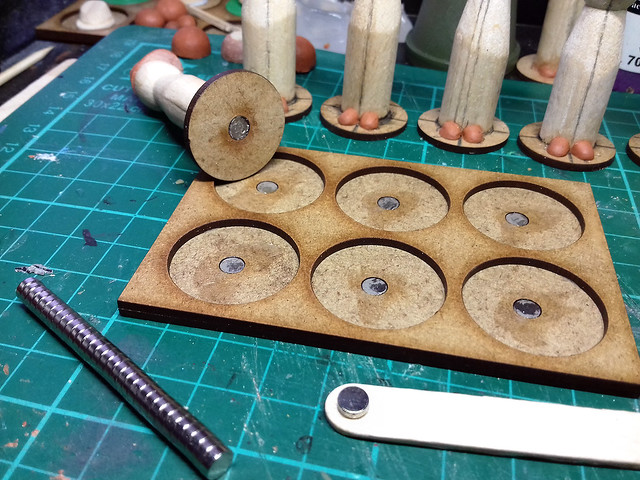 |
| Adding the small magnets to my unit tray and to the bottom of my peg soldiers. The lolly stick with attached magnet is a trick I picked up from a guy called Herbert Erpaderp and it helps to ensure I mount all my magnets with the correct polarity. |
I'm still not completely happy with the way I'm doing 'feet' - all individually hand-made with Milliput - I'd like a 'prefabricated' option for the boots. This maybe something else I can cast and then simply stick on. I will have to experiment.
That small niggle aside (it's still a learning experience for me) It's really exciting to have completed my very first peg soldier 'regiment'. Ranks of toy soldiers look terrific and really give me a buzz both as a display piece and as a wargaming item...
And that's the construction phase. A few minor niggles - which I hope to iron out with practise - but in the main I'm pleased with the Chasseurs so far. The next challenge, though, will be the painting.
Wednesday, 18 April 2018
French 'Chasseurs à pied', 1870 - Part 1
This is very exciting for me. It's not only a chance to really get back into making Victorian/Edwardian era 'toy soldiers' but it should be a relatively quick project in which I produce a full French 'regiment' in one go!
Of course, the trick to this is that - under the 'Portable Wargame' rules that I am using as a guide - I only have to make six figures to represent a 'regiment'.
Having already started my prototype peg-soldier for this project I begin by preparing the other five 'dolly pegs' to make my formation. These traditional beechwood pegs need to be trimmed down to the 42mm scale figures that I am using for this job.
The 'Chasseurs à pied' of the Franco-Prussian War
Just a quick overview about the French troop type I'm making. From what I understand, the title 'Chasseurs' translates into something like 'hunters'. They were light infantry (and also occassionally mounted units) that were the rapid response force of their day.
...As such I suppose they are the equivalent of the German Jäger (which also translates into 'hunter') and were intended to act as skirmishers, scouts and sharpshooters.
What attracted me to them was that they fielded a uniform that was a lot more subdued than the usual - flamboyant - French infantry get-ups of the day. Historically, the distinctive colour of this sort of light rifle regiment is dark green (as with the German Jäger or British Royal Green Jackets) and the unit insignia is the hunting horn. But the French Chasseurs were dressed mainly in a very dark blue, although they sported dark green epaulettes and wore the hunting horn on their kepi.
Designing the Peg Uniform
Obviously, my peg-soldiers are highly simplified caricatures and not historic figurines. I don't want to clutter and embellish the 'peg doll' idea so I have to streamline uniform designs to fit in with this format. Things like backpacks and webbing gear, water bottles and other military accoutrements are ditched in favour of the 'toy soldier' look...
The only thing I was a bit unsure about was whether the trousers should be slightly lighter blue as the various pictorial reference I have found seems a little contradictory about this (compare the two contemporary illustrations I have included at the top of this post). Otherwise, I'm quite happy with this look, I just have to find comparable Vallejo acrylic paints in my collection.
Well, that's it for now, I have a lot of basic construction to do - not least the addition of the kepi hats that I am currently casting - before I start to think about painting. I also have six little rifles to make out of wooden lolly sticks! :)
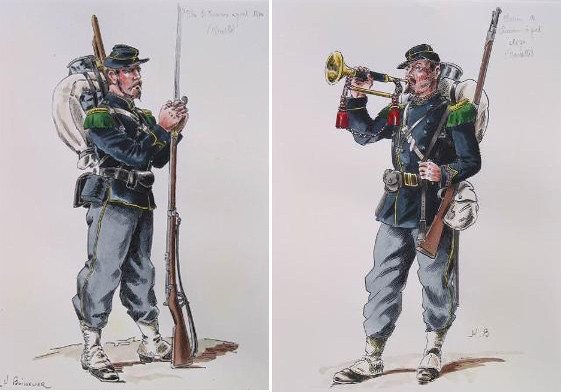 |
| The French Light Rifle Infantry - Chasseurs - circa 1870. The inspiration for my first 'peg regiment'. |
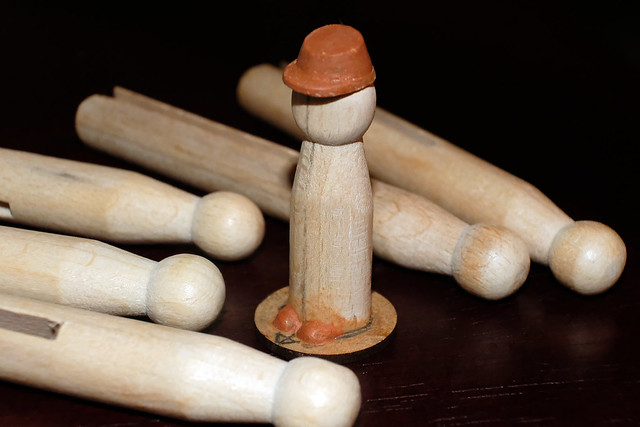 |
| A late evening start to my project. I assemble five additional pegs and begin to sketch out the cutting and sanding dimensions on them with a pencil. |
Having already started my prototype peg-soldier for this project I begin by preparing the other five 'dolly pegs' to make my formation. These traditional beechwood pegs need to be trimmed down to the 42mm scale figures that I am using for this job.
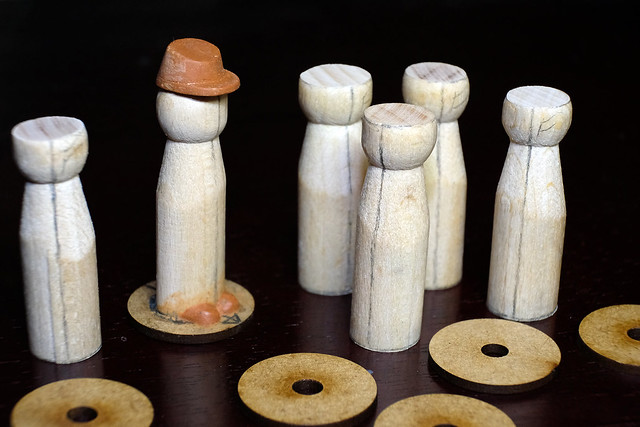 |
| Pegs prepped and ready to mount on their bases. |
Just a quick overview about the French troop type I'm making. From what I understand, the title 'Chasseurs' translates into something like 'hunters'. They were light infantry (and also occassionally mounted units) that were the rapid response force of their day.
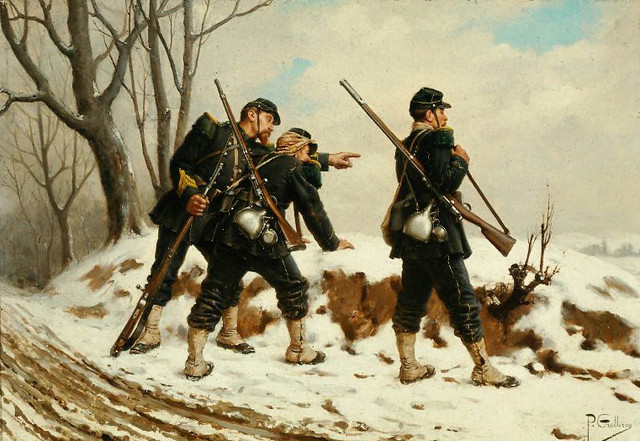 |
| French Chasseurs à pied in the snow. |
What attracted me to them was that they fielded a uniform that was a lot more subdued than the usual - flamboyant - French infantry get-ups of the day. Historically, the distinctive colour of this sort of light rifle regiment is dark green (as with the German Jäger or British Royal Green Jackets) and the unit insignia is the hunting horn. But the French Chasseurs were dressed mainly in a very dark blue, although they sported dark green epaulettes and wore the hunting horn on their kepi.
Designing the Peg Uniform
Obviously, my peg-soldiers are highly simplified caricatures and not historic figurines. I don't want to clutter and embellish the 'peg doll' idea so I have to streamline uniform designs to fit in with this format. Things like backpacks and webbing gear, water bottles and other military accoutrements are ditched in favour of the 'toy soldier' look...
The only thing I was a bit unsure about was whether the trousers should be slightly lighter blue as the various pictorial reference I have found seems a little contradictory about this (compare the two contemporary illustrations I have included at the top of this post). Otherwise, I'm quite happy with this look, I just have to find comparable Vallejo acrylic paints in my collection.
Well, that's it for now, I have a lot of basic construction to do - not least the addition of the kepi hats that I am currently casting - before I start to think about painting. I also have six little rifles to make out of wooden lolly sticks! :)
Monday, 16 April 2018
Casting Headgear Experiment
Continuing on from my last post where I tried to restart my project plan for this blog (create a 'peg soldier' army), today I took a look at my initial casting experiments. This very quick and simple experiment was really so I could witness the process involved in using Oyumaru Instant Mold. I didn't put much planning into it, I just followed the instructions to see if I could produce some castings.
Well, the good news is that the process worked fine!
My only criticism is that I pressed in too much Milliput putty so left myself with a little too much excess, which I would now have to cut away. But, it's no biggy as the main goal was just to see if I got anything to cast at all.
Moving forward I could be a little more careful about filling my moulds OR (as some have commented) don't build up my moulds so that they allow so much overflow (another comment suggested that I cut down my hardened mould, as I did with the Pickelhaub mould, so that the putty I use just comes up to the top of the mould casting). Either way, I'll move on to making more economical and better shaped moulds the next time.
The level of detail is good enough for me and - as I suspected - using Milliput means that I have a very hard cast object. (So it was worth the wait.)
Getting into Hot Water!
By the way, on a procedural issue, I have to confess that I didn't monitor the temperature of my hot water - with a thermometer, as in some tutorials - when I soaked my Instant Mold. I took the easy route and just boiled a kettle and used the boiling water straight out of that. The Instant Mold softened in three minutes, so you don't have to be absolutely exact in your temperature monitoring! :)
Finishing Off the Casting
Well, how difficult was it to trim away the excess Milliput? Actually, it was easy - I used a Tamiya Craft Saw (like a craft knife with a fine saw-blade) and it went through the Milliput very quickly...
Not bad (for a first attempt)! I'll start banging these out for my first peg-soldier 'regiment' - some French Chasseurs à Pied (light infantry) - I just need six Kepis.
Oyumaru Instant Mold Summery
Well, it turned out not to be rocket science and it's a great little product for what it is. If you are a plastic kit or miniatures modeller this is a fantastic 'emergency' component copier. I've lost small kit parts before and if they are part of a pair Instant Mold can allow you to duplicate the part you need or make extra parts if you want.
It is what it is though, don't think it's ideal for banging out a large number of objects. I'm probably stretching it's capabilities with my need for half a dozen duplicates, particularly because I am using slow hardening Milliput. (I'll look into some other faster hardening casting mediums, like plumbers silicone for example, etc).
But there you go. Quick and easy duplication - I think I'll try a two part mould at some point.
Well, the good news is that the process worked fine!
My only criticism is that I pressed in too much Milliput putty so left myself with a little too much excess, which I would now have to cut away. But, it's no biggy as the main goal was just to see if I got anything to cast at all.
Moving forward I could be a little more careful about filling my moulds OR (as some have commented) don't build up my moulds so that they allow so much overflow (another comment suggested that I cut down my hardened mould, as I did with the Pickelhaub mould, so that the putty I use just comes up to the top of the mould casting). Either way, I'll move on to making more economical and better shaped moulds the next time.
The level of detail is good enough for me and - as I suspected - using Milliput means that I have a very hard cast object. (So it was worth the wait.)
Getting into Hot Water!
By the way, on a procedural issue, I have to confess that I didn't monitor the temperature of my hot water - with a thermometer, as in some tutorials - when I soaked my Instant Mold. I took the easy route and just boiled a kettle and used the boiling water straight out of that. The Instant Mold softened in three minutes, so you don't have to be absolutely exact in your temperature monitoring! :)
Finishing Off the Casting
Well, how difficult was it to trim away the excess Milliput? Actually, it was easy - I used a Tamiya Craft Saw (like a craft knife with a fine saw-blade) and it went through the Milliput very quickly...
Not bad (for a first attempt)! I'll start banging these out for my first peg-soldier 'regiment' - some French Chasseurs à Pied (light infantry) - I just need six Kepis.
Oyumaru Instant Mold Summery
Well, it turned out not to be rocket science and it's a great little product for what it is. If you are a plastic kit or miniatures modeller this is a fantastic 'emergency' component copier. I've lost small kit parts before and if they are part of a pair Instant Mold can allow you to duplicate the part you need or make extra parts if you want.
It is what it is though, don't think it's ideal for banging out a large number of objects. I'm probably stretching it's capabilities with my need for half a dozen duplicates, particularly because I am using slow hardening Milliput. (I'll look into some other faster hardening casting mediums, like plumbers silicone for example, etc).
But there you go. Quick and easy duplication - I think I'll try a two part mould at some point.
Sunday, 15 April 2018
April Update
Well, it's been an unproductive month since my last update due to illness (again). I'm afraid that when I don't feel well I don't feel 'creative', so things tend to grind to a halt. BUT, I'm starting to feel a bit better now, so I've spent the weekend tidying my work-tray and remembering where I left off.
I also did a pit of peg-painting, though, although not military related it did get me some practise. It was just a couple of peg-people gifts for some friends...
As I say, not military but these little figures did teach me a couple of things that I can bring forward and apply to my peg-soldiers.
One of the main lessons was about using 'permanent' markers. I tried using water-proof pens for drawing the fine outlines and to begin with it looked like it was working well (I invested in some good quality permanent markers this time). But, much to my horror, the spray varnish I used to gloss the finished figures reacted with the pen ink and the lines all ran!
After the initial shock, I picked myself up and did a careful repair job and managed to salvage this model. The lesson for me was - stick to outlining with acrylics and a brush!
I *believe* that the spray acrylic lacquer I use although 'acrylic' contains a spirit based propellant (?) and this is what reacted and reactivated the pen ink and made it run. I've bough a can of brush on varnish to experiment with to see if this makes any different, as using pens is a quick and effective way of drawing sharp lines. We shall see.
Anyway, back to military themes...
My plan is to do a small army of peg-soldiers for a tabletop game based on the Portable War-game rules. In the format I have chosen 'regiments' will be symbolic and made up of six figures in each unit (for infantry).
The campaign I am interested in is the Franco-Prussian War of 1870/71, ideal Victorian 'toy soldier' inspiration. This conflict featured a plethora of colourful uniforms on both sides, particularly because (and forgive me here because I am not a historian) because at this point Germany was still a sort of confederation of allied independent kingdoms.
France, of course, was it's usual flamboyant self and fielded some wonderfully romantic uniforms (which had already had a big influence on the earlier American Civil War of the 1860s). But the German confederation - while perhaps a little more sober - had not quite yet succumbed to a unified and standardised 'field grey' and each minor kingdom had it's own distinctive collection of uniforms.
I hope to illustrate this diversity in a - as yet - non-unified greater Germany by including some of the less well-known troop types and not just the infamous, Pickelhaube helmeted Prussians!
To help me along in my uniform choices I am referring to Osprey's excellent Men-at-Arms 'German Armies' 1870-71 (vols. 1 & 2) and their 'French Army 1870-71' (vols. 1 & 2).
Production Issues - Helmets
Something I've mentioned before is my worries over how to replicate the distinctive headgear. Cutting all my 'parts' from just the basic wooden peg, while satisfying in it's way, is a bit limiting, especially if you want to create more complex components. (Think about the unique German Pickelhaube helmet and you'll understand the problem...How do I cut that out of a cylindrical piece of wood?)
So, after a long think I decided to 'cheat' and make the headgear as composite object using as much wood as I can but then adding the tricky details using modelling putty to make a master prototype. Once done, I will them copy the design by creating mould and casting a clone in Milliput putty...Simples. (?)
I'll be having a crack at this process using a product called 'Instant Mold' (I don't want to get into resin casting for these short run duplications.
So, to begin I need some basic wooden geometric or primary shapes to start off with. I'm starting with a French Kepi and the dome for a Prussian Pickelhaube. Although the Kepi is complete and made from wood it is a bit tricky to duplicate because of the sloped and obliquely cut top, which is why I want to cast it instead. The Pickelhaube dome will be the basis for further sculpting using Milliput putty, but I want a shaped blank to start with, so I'm casting this too...
This *should* be a easy process (according to the YouTube tutorials I have watched) and should simply entail my pressing the hat shapes into the softened Instant Mold to create copies of the shapes I want to cast. Going on my experience, though, nothing is ever straight forward the first time you do it!
First issue...How many sticks of Instant Mold do I use? I guess this is the sort of knowledge that will only come with experience...I'm going to guess two...
Good guess! Turns out you need to allow a good margin of Instant Mold to surround your object (remember you are *pressing* the object into the mould material) and you have to make sure you have enough depth of Instant Mould (so you don't press the object right through the Instant Mold).
Anyway, to the process...You can measure the temperature and boil your water in a pan (or nuke it in a microwave) but I simply boiled the kettle and that seemed to suffice. The Instant Mold was dropped into the water (in a Pyrex bowl) and began to soften in the boiling water after about two to three minutes...
Now, the trick seems to be - work fast! You need to make your mould as quick as you can while the Instant Mold is at it's softest. This ensures that you can push the Instant Mold tightly into your object, without gaps and surround the object completely...
It took me two goes as I worked too slowly the first time and it started to harden as I was moulding the Instant Mold around my objects (you live and learn)...BUT, the great thing about Instant Mold is that if you are not happy with your mould, then just pop it back into more boiling water and start gain!
I tried to form the Instant Mold into a sort of block(ish) around the object and press it firmly against the object to ensure I get an exact clone of my original shape. Being clear helps to spot air pockets, gaps or bubble I guess. I then left the mould to cool and harden, I didn't really time this but it didn't take all that long.
One thing I tried out, though, was that I used a new craft knife blade and trimmed the hardened Instant Mold down, roughly level with the top of the Pickelhaube blank. I did this to see if I could do a neat casting exactly to the shape of my object, without too much excess that I will have to trim off later. The Kepi mould was left alone to see what would happen...
And so, finally, onto the casting stage. Again, this should be simple, I just need to press my chosen casting medium (Milliput in my case) into the mould - hopefully without air bubbles or gaps (here the transparency of Instant Mold helps gain) - and then leave the casting to dry. Milliput normally takes overnight to cure, but there are other mediums that dry a lot quicker (I'll try some of these later), but I like the final hardness of Milliput so I'm willing to wait...
Now, obviously, my mould is a very simple single-piece press mould, but Instant Mold is capable of being used to create a more advanced two-part mould. These might create a neater casting with a little less waste, but I think I might get a bit more economical in my casting with a bit of practise.
Anyway, the wait begins. So I'll end here and see how my castings work out. But it's good to get producing again.
I also did a pit of peg-painting, though, although not military related it did get me some practise. It was just a couple of peg-people gifts for some friends...
As I say, not military but these little figures did teach me a couple of things that I can bring forward and apply to my peg-soldiers.
One of the main lessons was about using 'permanent' markers. I tried using water-proof pens for drawing the fine outlines and to begin with it looked like it was working well (I invested in some good quality permanent markers this time). But, much to my horror, the spray varnish I used to gloss the finished figures reacted with the pen ink and the lines all ran!
After the initial shock, I picked myself up and did a careful repair job and managed to salvage this model. The lesson for me was - stick to outlining with acrylics and a brush!
I *believe* that the spray acrylic lacquer I use although 'acrylic' contains a spirit based propellant (?) and this is what reacted and reactivated the pen ink and made it run. I've bough a can of brush on varnish to experiment with to see if this makes any different, as using pens is a quick and effective way of drawing sharp lines. We shall see.
Anyway, back to military themes...
My plan is to do a small army of peg-soldiers for a tabletop game based on the Portable War-game rules. In the format I have chosen 'regiments' will be symbolic and made up of six figures in each unit (for infantry).
The campaign I am interested in is the Franco-Prussian War of 1870/71, ideal Victorian 'toy soldier' inspiration. This conflict featured a plethora of colourful uniforms on both sides, particularly because (and forgive me here because I am not a historian) because at this point Germany was still a sort of confederation of allied independent kingdoms.
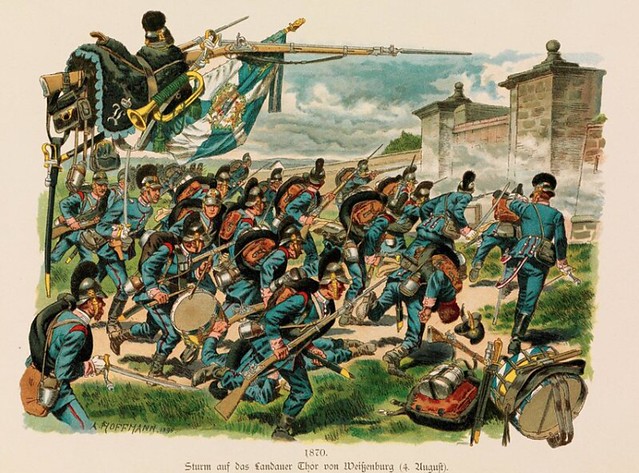 |
| Just one of the many varied uniforms of the German Allies, here Bavarian troops are involved in an assault at the battle of Wissembourg, 1870. |
I hope to illustrate this diversity in a - as yet - non-unified greater Germany by including some of the less well-known troop types and not just the infamous, Pickelhaube helmeted Prussians!
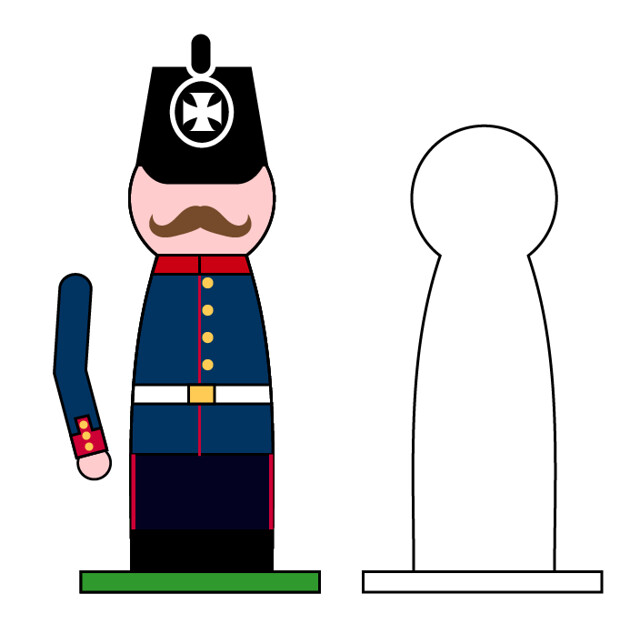 |
| My sketch for a German infantryman (Landwehr). I've simplified the uniform and equipment to compliment the peg format and also to be a little more 'toy soldier' looking. |
To help me along in my uniform choices I am referring to Osprey's excellent Men-at-Arms 'German Armies' 1870-71 (vols. 1 & 2) and their 'French Army 1870-71' (vols. 1 & 2).
Something I've mentioned before is my worries over how to replicate the distinctive headgear. Cutting all my 'parts' from just the basic wooden peg, while satisfying in it's way, is a bit limiting, especially if you want to create more complex components. (Think about the unique German Pickelhaube helmet and you'll understand the problem...How do I cut that out of a cylindrical piece of wood?)
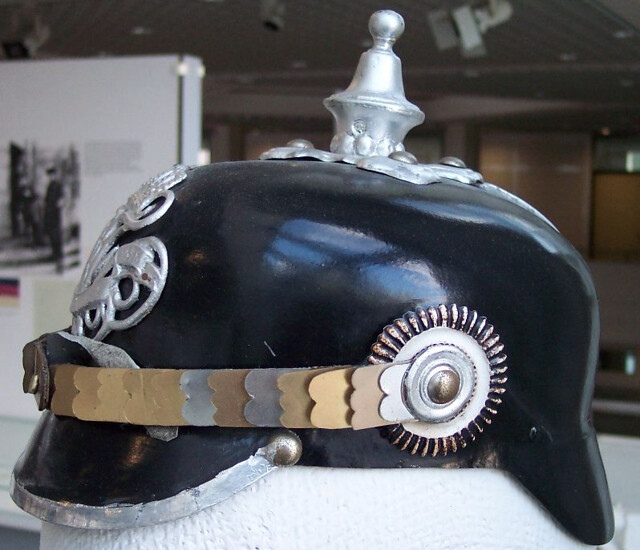 |
| A Prussian Pickelhaube, how would I make that from a peg? |
So, after a long think I decided to 'cheat' and make the headgear as composite object using as much wood as I can but then adding the tricky details using modelling putty to make a master prototype. Once done, I will them copy the design by creating mould and casting a clone in Milliput putty...Simples. (?)
I'll be having a crack at this process using a product called 'Instant Mold' (I don't want to get into resin casting for these short run duplications.
So, to begin I need some basic wooden geometric or primary shapes to start off with. I'm starting with a French Kepi and the dome for a Prussian Pickelhaube. Although the Kepi is complete and made from wood it is a bit tricky to duplicate because of the sloped and obliquely cut top, which is why I want to cast it instead. The Pickelhaube dome will be the basis for further sculpting using Milliput putty, but I want a shaped blank to start with, so I'm casting this too...
This *should* be a easy process (according to the YouTube tutorials I have watched) and should simply entail my pressing the hat shapes into the softened Instant Mold to create copies of the shapes I want to cast. Going on my experience, though, nothing is ever straight forward the first time you do it!
First issue...How many sticks of Instant Mold do I use? I guess this is the sort of knowledge that will only come with experience...I'm going to guess two...
Good guess! Turns out you need to allow a good margin of Instant Mold to surround your object (remember you are *pressing* the object into the mould material) and you have to make sure you have enough depth of Instant Mould (so you don't press the object right through the Instant Mold).
Anyway, to the process...You can measure the temperature and boil your water in a pan (or nuke it in a microwave) but I simply boiled the kettle and that seemed to suffice. The Instant Mold was dropped into the water (in a Pyrex bowl) and began to soften in the boiling water after about two to three minutes...
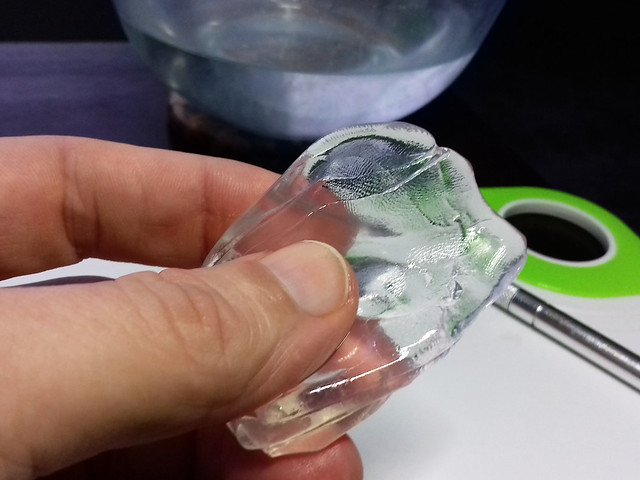 |
| Mind you fingers getting the Instant Mold out the boiling water. I used a craft knife to get it out. |
It took me two goes as I worked too slowly the first time and it started to harden as I was moulding the Instant Mold around my objects (you live and learn)...BUT, the great thing about Instant Mold is that if you are not happy with your mould, then just pop it back into more boiling water and start gain!
I tried to form the Instant Mold into a sort of block(ish) around the object and press it firmly against the object to ensure I get an exact clone of my original shape. Being clear helps to spot air pockets, gaps or bubble I guess. I then left the mould to cool and harden, I didn't really time this but it didn't take all that long.
One thing I tried out, though, was that I used a new craft knife blade and trimmed the hardened Instant Mold down, roughly level with the top of the Pickelhaube blank. I did this to see if I could do a neat casting exactly to the shape of my object, without too much excess that I will have to trim off later. The Kepi mould was left alone to see what would happen...
And so, finally, onto the casting stage. Again, this should be simple, I just need to press my chosen casting medium (Milliput in my case) into the mould - hopefully without air bubbles or gaps (here the transparency of Instant Mold helps gain) - and then leave the casting to dry. Milliput normally takes overnight to cure, but there are other mediums that dry a lot quicker (I'll try some of these later), but I like the final hardness of Milliput so I'm willing to wait...
Now, obviously, my mould is a very simple single-piece press mould, but Instant Mold is capable of being used to create a more advanced two-part mould. These might create a neater casting with a little less waste, but I think I might get a bit more economical in my casting with a bit of practise.
Anyway, the wait begins. So I'll end here and see how my castings work out. But it's good to get producing again.
Subscribe to:
Posts (Atom)
